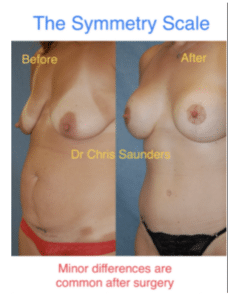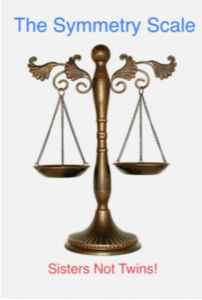It is normal to have some asymmetry after all cosmetic procedures. It should be considered to be part of normal results, healing, and expectations. Some degree of asymmetry or differences between one side and the other is to be considered normal. This occurs no matter how meticulous and expert the surgeon. With breast surgery results, understanding that breasts will be slightly different can be described as “SISTERS NOT TWINS.” This phrase underscores how it’s normal for the breasts to not perfectly match after plastic surgery. This educational writing focuses on this topic. It was written at the request of a patient from Media, PA.
Most plastic and cosmetic operations involve working on both sides of the body. It’s not just with breast operations. With a facelift, there is a left and right side. The face typically has differences between one side and the other, before the operation. After the facelift operation, no matter how expert the doctor is, there are typically minor differences afterwards. But understand, these differences typically are small and minor, and most patients are extremely happy with the results. It can be frustrating to patients who don’t have REALISTIC EXPECTATIONS. When it’s not exactly the same on both sides, people can have lower satisfaction even when the results are excellent.
It is not common to be PERFECT after an operation in regards to symmetry. This is true about most cosmetic results. Realistic expectations are important to understand after all operations. Breast augmentation or breast lift surgery obviously has a left and right side. Small differences will exist after surgery. They almost always are present before operating as well. Tummy tuck and liposuction will involve work on both sides of the body. No matter how good or perfect the surgeon is asymmetry will occur as part of the results. It’s extremely important to understand this concept.
The Symmetry Scale:
Differences can be described or thought of as part of a symmetry scale. The scale is 1 – 10. In this scale, 10 is a perfect score or perfect symmetry, with no asymmetry. A score of 1 would be very poor symmetry and lots of asymmetry. The goal of surgery is 10 out of 10 on the symmetry scale and a perfect set of matching breasts. However, this result is often expecting too much. It’s normal to have differences between the breasts. Remember, “sisters not twins.” More realistic expectations would be 8 out of 10. Some degree of differences between the breasts is normal and common. It’s imperative to understand that these results are for ALL plastic surgeons. Some patients will think the best surgeon will have perfect symmetry every time. This is not understanding cosmetic surgery and its limitations.
Imagine you have had cosmetic surgery. Your breasts are “sisters.” The left breast is beautiful. So is the right breast! But they are slightly different, just like beautiful sisters. Overall, there is lots of symmetry, but there are some minor differences. One breast might be slightly larger or higher. One nipple might be slightly different from the other side. This is a normal result. Small differences in the nipples, breast shape, and/or breast volume are normal results after surgery, and they should be expected.
Beauty is in the Eye of the Beholder:
What is beautiful or what is minor asymmetry is in the “eye of the beholder.” A patient might see the difference between their breasts after augmentation or a lift as being a bigger amount or degree than the doctor. She might be frustrated by the differences. The doctor might see it as just minor and normal. What I will describe to my patients is the following scenario. We have 10 plastic surgeons examine the patient. The patient is an 8 out of 10. She doesn’t like the differences she sees. All she sees is the asymmetry between her breasts. The plastic surgeons do the examination. They will typically say “You have good symmetry!” Cosmetic surgery breast results have some degree of differences between the breasts. Realist expectations are important to understand that these differences are common. They usually are minor.
What Can be Done?
If it is determined that the asymmetry is more than a reasonable or normal amount, then surgical revision might be necessary. This means an operation to improve the result and improve symmetry. Although it depends on the individual situation, most of the time it doesn’t entail redoing the whole operation. Often significant improvement can be made with the re-do or revision operations. This topic is reviewed in another educational writing on revision operations. Surgery can give the patient improved results for those who are not satisfied.
Nature and Beauty have Asymmetry too:
Being slightly asymmetric is often viewed as normal, and many regard it as beautiful. It’s natural to be slightly different on one side versus the other. This is true with bonsai art. Bonsai plants are one of my hobbies. I study the beauty in bonsai plants, and I like to cultivate them. Jade bonsai trees are one of my favorites. Perfect symmetry is not the goal with bonsai tress. The tree is not put in the exact center of the pot. The tree is not perfectly straight up and down. It should be angled slightly to be more natural and normal. Branches and other characteristics should be odd numbered. For example, 3 or 5 branches are more beautiful than 2 or 4. Nature is not perfectly symmetric and neither is our body. It’s normal and beautiful to have some differences between sides.
Summary:
Plastic surgery and cosmetic breast operations can make fantastic improvements in a women’s appearance. Larger, fuller, and more perky results are common. It is normal after surgery to have some minor differences. This is described as “sisters not twins.” A symmetry scale can be used to understand this concept. Results will often give symmetry that is not a perfect 10 out of 10. Realistic expectations are important to understand. These concepts also apply to most cosmetic surgery operations.






